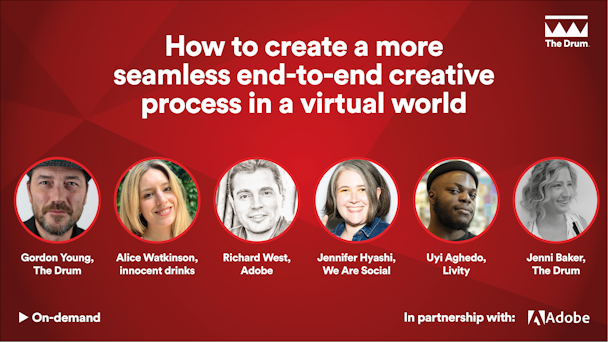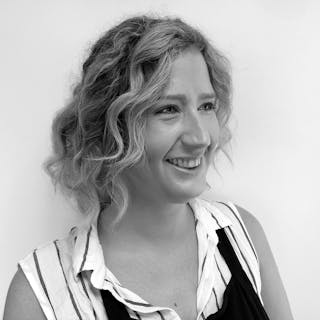Creatives reveal their ‘New Era Resolutions’ for working life after lockdown
Rewind to March 2020 and the idea of working remotely filled many across the industry with dread. How can creativity be maintained without the interactions through which some of the best creative ideas are born and developed? Fast forward to ‘Freedom Day’ and that picture has changed. The fear quickly faded and, thanks to better flexibility and the digital tools at our disposal to enable creative collaboration, some say it has even been an improvement on what came before.

Watch: How to create a more seamless end-to-end creative process in a virtual world
Following the launch of a new white paper – Creativity, collaboration and culture: the impact of working from home for marketers and marketing – that is based on a focus group and survey of over 100 marketing professionals and creatives, The Drum and Adobe enlisted a panel to offer their views on the findings. They explored how the creative collaboration process has changed and how new ways of working have helped transform not just the quality of creative work, but the lives of creatives, forever.
In a nod to what the future of work could look like, the hybrid event took place at The Drum Labs, with Gordon Young, co-founder and editor-in-chief of The Drum, joined in the studio by Trapart creative director Uyi Aghedo and We Are Social senior designer Jennifer Hayashi, while Richard West, who is Adobe’s senior manager of strategic development, international design and content solutions, and Alice Wall, graphic designer at Innocent, dialed in remotely to participate in the discussion.
Watch the full panel discussion above.
Once the industry got over the initial shock of working from home, the survey and panelists confirmed that many have embraced the flexibility and freedom to carry out some of their best work. For creative people in particular, their work is not linear, so having the extra head space and different sources of inspiration has had a positive impact on their creative output and quality of work.
Not only that, it has also forced many to explore different techniques during lockdown that provided a much more logical way of working and enabled them to collaborate with other team members and clients much more efficiently, pushing the boundaries of functionality with different tools.
“The whole buildup of our collaborative applications and the integration between them has really come to the fore during lockdown,” says West. “It has meant that people have been able to use the technology we’ve built a lot more effectively than they have done in the past.”
Innocent’s Wall agrees, adding that her team has been using technology differently since the beginning of the first lockdown, with more focus on getting value out of it.
“Before, it was so easy to dismiss stuff because it took a bit of time to work out or get everyone on board,” she says. “But this has forced everyone to properly look at where the value lies with different technology and what amazing tools we have at our disposal, not only for design but also for communication. Those barriers have completely been broken down and it’s a huge step forward.”
While the panelists agree with the survey that remote working tools have made interactions with clients much more accessible, Hayashi notes that there have been obstacles to overcome to ensure teams are all included and able to collaborate in that way – particularly for those who are introverted. That’s where the interactivity that comes with workplace chat tools has made things easier, with the ability to have ongoing conversations in a more relaxed, informal environment.
“It’s important to stay creatively active, so if we can still find a way to bring people in and keep people around us, that’s where we get inspiration from,” adds Aghedo.
How could Creative Cloud for teams help you? Designed for creativity, built for business.
More sausage, less sizzle
The panelists also touched on the democratization going on in the pitching process. They agreed that there has been a greater focus on “the sausage rather than the sizzle” – meaning that when you take away the ability to read the room, the creative must sell itself – and the technology being used in the background allows you to conduct pitches more succinctly, providing more interaction.
Now, as we transition from extreme lockdown to adopting more hybrid approaches of working, Hayashi insists “we need to be open for the future and what that means”. It might provide a healthier balance, but there are also some “interesting technical challenges” to overcome.
On the birth of this new era, the panelists wrap up the session by offering their ‘New Era Resolution’, which include keeping the right balance, opening up to external influences and absorbing energy from other people, as well as pushing the boundaries of technology’s role in the collaboration process.
“As creatives, we’re constantly looking for these alternative worlds that we can either create or adjust, and it’s something I look forward to doing more going forward once things open back up,” says Aghedo. “I think we’ll come back with a lot of new energy and new knowledge.”
West, meanwhile, concludes that “time has become so much more compressed in lockdown”. He says: “You need to use technology to save yourself and buy yourself some time, and get that work-life balance back by using AI and use the implementation of technology more for collaboration, taking the time to learn, invest and train up on something new.”
Content created with:

Adobe
Work management. Built for the enterprise. Connect, collaborate, and execute on complex workflows - from anywhere.
Find out more
